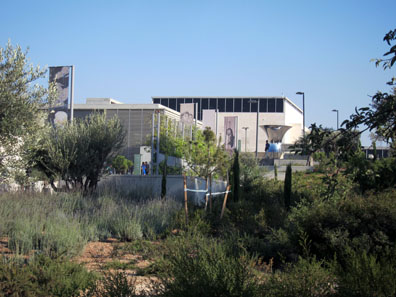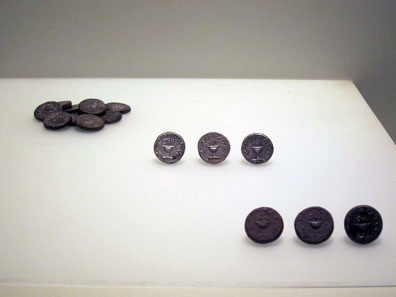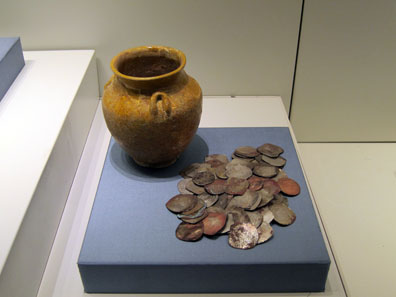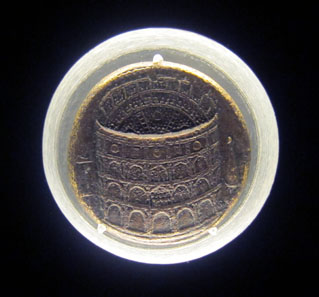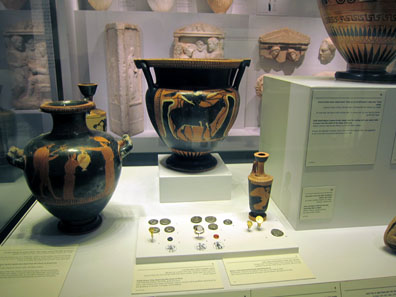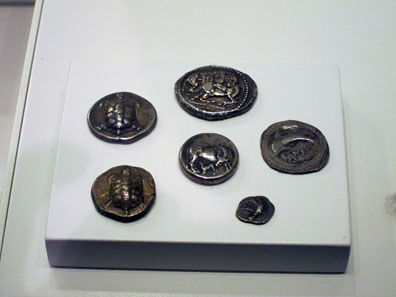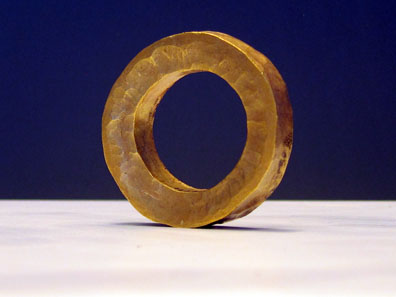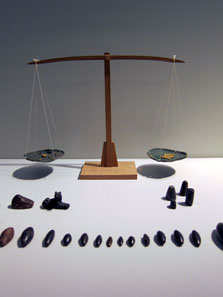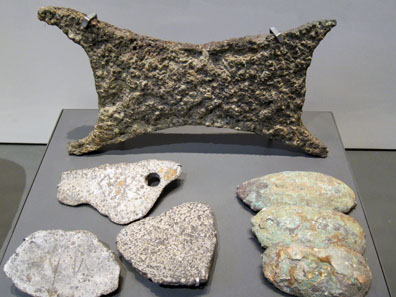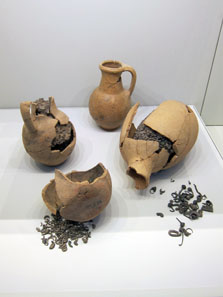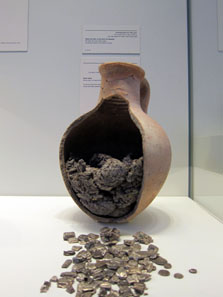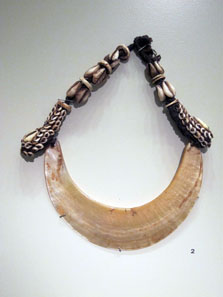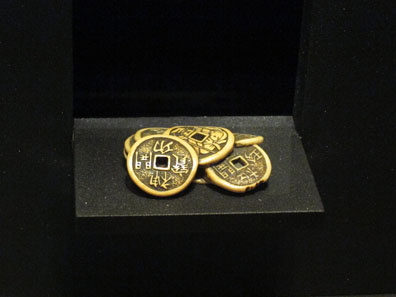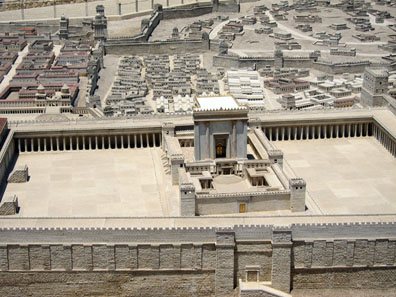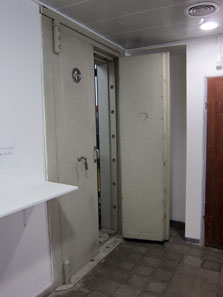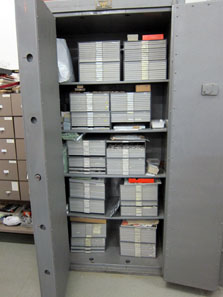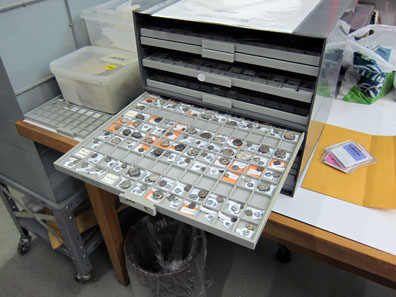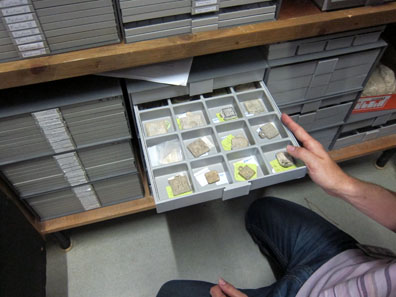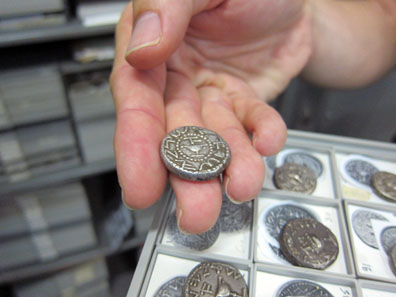by Ursula Kampmann
July 5, 2012 – Actually, to be precise numismatics concentrates on quite a narrow space in Jerusalem. There is the Israel Museum, which accomodates beside its own collection the Israel Antiquities Authority as well. And only a fifteen minutes’ walk from there you will find the exhibition of the Bank of Israel.
Israel Museum. Photo: UK.
The Israel Museum is a building whose interior decoration impresses by attending to all wants a modern tourist might have. However, those who are going to the coin cabinet don’t enter this building. Slightly staggered to the left there is an entrance guarded by a door-keeper which conducts to a labyrinth of narrow corridors lodging many various offices.
Yaniv Schauer shows us a case the Israel Museum is particularly proud of: findings from Masada. Photo: UK.
These rooms are small and cramped, full of computers technically not quite up to date. This, however, does not mean anything. I have seen many coin cabinets where supreme scientific results were achieved by using a minimum of equipment. And here it’s the same. It is impossible to list all the numerous publications that spring from the numismatic department of the Israel Museum.
And in addition the objects shown in the exhibition are fabulous, particularly because some showpieces from other collections are presented here, too, …
A coin hoard composed of shekels dating from the First Jewish War. Photo: UK.
… as for instance a coin hoard from the famous fortress of Masada which was still defended against the Romans after Jerusalem had been taken by Titus in 73 CE. Actually it is property of the Bank of Israel. In the foreground on the right you see the celebrated shekels of year 5, struck between March 21 and August 4, 70 CE.
Finds from caverns where warriors sought shelter after the defeat in the Bar Kokhba revolt. Photo: UK.
Finds from the Bar Kokhba revolt (132-135) or rather the following time are on display, too. The coins come from caverns in Judaea where warriors hid after they had been beaten in the course of the Bar Kokhba revolt.
Coin hoard from Tiberias, buried between 952 and 977. Photo: UK.
The number of coin hoards in the Israel Museum is really impressive. Nearly every section features one of them. This is a coin hoard from Dirhems buried in Tiberias between 952 and 977. The silver coins were issued by the Carmathians, a radical Islamic cult whose members raided Israel a couple of times ruling even parts of the country for some short time.
The coin exhibition. Photo: UK.
The coin exhibition’s heart is a circular room dedicated exclusively to numismatics. There are on display only few, but gorgeous coins in order to raise the visitors’ curiosity without boring the non-professional.
Sestertius of Titus picturing the Colosseum. Photo: UK.
The coins are shown as precious treasures inserted at eye-level into the wall with a black background.
Images of Greek gods on vessels, jewels and coins. Photo: UK.
To whom that’s not enough – there are coins everywhere in the archaeological wing. For example, this showcase presents the Greek gods featured on coins, too.
Coins with animals. Photo: UK.
This image shows the quality of the coins on display. All these pieces feature images of animals.
Gold rings as means of payment, c. 6,500-5,500 years old. Photo: UK.
Anyway, there are many things of numismatic interest in all the other galleries, too. For instance some objects from the time when coins did not exist yet, but when weighed precious metal was used instead as means of payment for important transactions. Particular exciting are eight rings of a total weight of around one kilogramme, six of them are made of electrum, two of pure gold.
A single gold ring. Photo: UK.
Discovered in Western Samaria they are between 6,500 and 5,500 years old thus belonging to the oldest gold objects of the world.
Balance from the 14th or 13th century with much older scale weights. Photo: UK.
Or a balance with standardised scale weights, some of them dating back even to the 17th century BCE …
Copper bars. Photo: UK.
… not forgetting the copper bars of various shapes. The big one, recalling a spread hide probably comes from Cyprus.
Hoard find from Eshtemoa, 9th to 8th century BCE. Photo: UK.
Whole showcases are filled up with silver scraps from hoard findings. These jugs were buried together and three of them bear the Hebrew word ‘five’. Probably the writer wished to express that they hold silver weighing 500 shekels.
Findings from Tel Dor, late 11th century BCE. Photo: UK.
Here for instance you can recognize that the silver was filled in small bags at first.
Feather money from Santa Cruz Island. Photo: UK.
And if you thought that numismatic objects were shown only in the archaeological section you would be surprised to hear that even in the ethnological section exciting objects are waiting to be discovered. Here, for instance, feather money from Santa Cruz Island, required to pay the bride price.
Pendant with kina. Photo: UK.
Or this kina from New Guinea to count just another example.
Netsuke of carved cash coins. Photo: UK.
Also especially nice is this netsuke of carved cash coins.
Altar from Tel Beersheba. Photo: UK.
A special link with numismatics has this reconstruction of an altar from the eighth century BCE since it was realized in honor of the renowned numismatist Herbert A. Cahn by his son David Cahn.
A model of Jerusalem in the time of the second temple. Photo: UK.
Although the gigantic model of Jerusalem in the time of the second temple exposed in the garden of the Israel Museum is not a numismatic object, it is quite impressive, however.
The entrance to the safe. Photo: UK.
Once again we were allowed to have a look behind the scenes. This is the entrance to the guarded room where the Israel Museum safe keeps its coin collection.
A glance into the safe. Photo: UK.
In cases and boards there are many BeBa boxes containing the collection.
The tray with the coins from the city of Gaza. Photo: UK.
Many collectors have donated to the Israel Museum their collections compiled over years.
The weights compiled by David Hendin in order to write his book ‘Ancient Scale Weights and pre-coinage currency of the Near East’. Photo: UK.
Here, for example you will find the weights compiled by David Hendin in order to write his excellent book on ancient weights and the pre-coinage currency of the Near East.
Prototype of year 1 shekel. Photo: UK.
The Israel Museum was founded in 1965 and since then it has been Israel’s national museum. Teddy Kollek, then Jerusalem’s mayor, was the driving force behind this enormous collection. Kollek himself was an active coin collector, no wonder the numismatic department was at the centre of attention since the beginning. At this time Ya’akov Meshorer – many coin collectors might know him by his numerous books on Jewish numismatics – was appointed chief curator. In 1969 he established the numismatic department of the Israel Museum remaining his curator until 1993.
Then he was succeeded by Haim Gitler, who is still chief curator. He reigns over more than 25,000-30,000 coins among them one of the best collections of Jewish coins worldwide (comprising the Meir Rosenberg Collection and the Abraham Bromberg Collection) and what we call ‘city coins’, or issues of cities on the territory of modern Israel under Roman rule. In addition the Paul Balog Collection is situated in the Israel Museum, a comprehensive collection of Islamic coins with a large part of Mamluk issues.
Website of the Israel Numismatic Society.
At the same time Haim Gitler is president of the Israel Numismatic Society, an association with branch offices in Jerusalem, Tel Aviv and Haifa. Its most relevant publication is the journal ‘Israel Numismatic Research’ well known outside of Israel too because of its many important articles.
If you want to learn more about the Israel Numismatic Society, please click here.
In part 2 of our contribution you will read more about the Israel Antiquities Authority, the museum of the Bank of Israel and the coin and antiquities trade in Israel.




